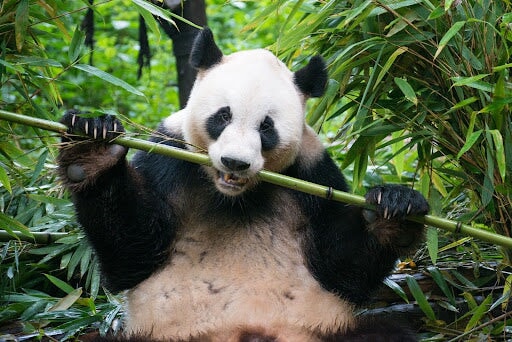
TLDR
Is bamboo edible? For pandas, of course it is. The giant panda, an emblem of wildlife conservation and a national treasure in China, has long captivated the world with its charming appearance and unique dietary habits. Central to the panda's life is an intriguing question: Why do these bear relatives, with the digestive system of a carnivore, feast predominantly on bamboo? This article will explore the fascinating reasons behind the giant panda's reliance on bamboo, delve into the intricacies of their digestive system, and examine human efforts to conserve their habitats while drawing a parallel with the sustainable practices of Reel Paper in producing bamboo toilet paper.
Understanding the Panda's Unique Diet
The diet of the giant panda is a fascinating topic that has intrigued scientists and animal lovers alike. While most of their bear relatives are omnivores or carnivores, pandas have developed a diet that is almost entirely herbivorous, focusing primarily on the bamboo plant. By understanding the nutritional dynamics and evolutionary journey of pandas' diet, we gain insight into their survival strategies and the delicate balance of their ecosystem.
The Nutritional Benefits of Bamboo for Pandas
Giant pandas have a diet that is almost exclusively bamboo, despite their digestive system being more suited to that of a carnivore [1]. Bamboo provides essential nutrients for pandas, though they must consume it in large quantities due to its low nutritional density. The leaves and shoots of bamboo species like arrow bamboo are particularly favored for their higher protein content compared to the woody stalks. Interestingly, the bamboo diet of pandas also plays a role in their reproductive success, with the nutritional intake affecting their ability to reproduce.
Adaptation Over Time: Pandas' Shift from Carnivores to Herbivores
The dietary shift of pandas from carnivores to herbivores is a remarkable evolutionary adaptation. Over millions of years, pandas have developed physical traits, such as strong jaws and flat molars, which are ideal for crushing and grinding fibrous bamboo [4]. This transition is also reflected in their gut microbiota, which, despite being similar to that of carnivorous bears, has adapted to process bamboo efficiently. This adaptation highlights the remarkable ability of species to evolve in response to changes in their environment and available resources.
The Digestive System of Pandas: Specialized for Bamboo
The digestive system of the giant panda is a marvel of nature's adaptation, uniquely evolved to handle a diet that is an anomaly among bears. Despite originating from a lineage of carnivores, pandas have adapted their gastrointestinal system to efficiently process and extract nutrients from bamboo, which forms the bulk of their diet.
How Pandas Efficiently Digest Bamboo
Despite lacking the typical herbivore's long digestive tract, pandas have a unique way of efficiently digesting bamboo. Their gut microbiota plays a crucial role in breaking down the cellulose in bamboo, allowing them to extract necessary nutrients.
The Role of Bamboo in Pandas' Energy and Hydration
Bamboo not only provides sustenance for pandas but also contributes significantly to their water intake. Given the high water content in bamboo shoots, pandas can rely less on external water sources. This aspect of their diet is essential, particularly in habitats where water may not be readily available year-round. This natural adaptation ensures that pandas stay hydrated, primarily through their food source, which is especially vital during the dry seasons.
Human Efforts in Conserving Panda Habitats
Knowing how to stop deforestation through human intervention plays a critical role in the conservation of panda habitats, an effort that is essential for the survival of this iconic species. As the natural habitats of giant pandas face threats from deforestation and human activities, concerted efforts by conservationists and organizations around the world are underway to preserve and restore these crucial ecosystems. Through these conservation strategies, we see a commitment to not only safeguarding the panda population but also to preserving the biodiversity and health of entire ecosystems where these remarkable animals reside.
Planting Bamboo Forests for Panda Survival
Human efforts in conservation, particularly in planting and maintaining bamboo forests, are vital for the survival of the giant panda. Organizations like the World Wildlife Fund and Pandas International have been actively involved in reforestation projects to ensure a steady food supply for wild pandas and to preserve their natural habitat. These conservation efforts not only provide a stable environment for pandas but also support biodiversity, as bamboo forests are home to various other species.
The Impact of Conservation on Panda Diets
Conservation efforts have a direct impact on the diet and health of giant pandas. By preserving and expanding bamboo forests, these initiatives ensure that pandas have access to the diverse bamboo species needed for a balanced diet, which is crucial for their overall health and breeding success. Furthermore, these conservation efforts help to mitigate the effects of habitat fragmentation [6], which can disrupt the pandas' access to various bamboo species and impact their nutritional intake.
Will Pandas Ever Eat Meat?
The dietary habits of the giant panda have long been a subject of curiosity, particularly regarding their almost exclusive consumption of bamboo despite having the digestive system of a carnivore. This raises an intriguing question: will pandas ever revert to eating meat?
Evolutionary Changes and Dietary Adaptations
Considering the evolutionary journey of the giant panda, it's unlikely they will revert to a carnivorous diet. Their physical adaptations and gut microbiota have evolved specifically to process bamboo, making a significant dietary shift improbable soon. This specialization, while beneficial for bamboo digestion, limits their ability to process other food types efficiently, including meat. The evolution of pandas' dietary habits is a fascinating study in adaptation, showcasing how species can undergo dramatic changes in their feeding behaviors over evolutionary timescales.

How Much Bamboo Do Pandas Eat Per Day?
Understanding the dietary needs of the giant panda is key to comprehending their unique lifestyle and the ecological challenges they face. These charismatic creatures consume an astonishing amount of bamboo each day, a fact that underscores the importance of their natural habitat's health and abundance.
The Daily Dietary Requirements of Pandas
To meet their energy and nutritional needs, giant pandas consume an astonishing amount of bamboo daily. Adult pandas can eat between 26 to 84 pounds of bamboo, depending on the species and the season. This high intake is necessary due to the low nutritional value of bamboo, requiring pandas to spend most of their day eating to fulfill their dietary needs. This constant feeding habit is a critical survival strategy for pandas, ensuring they get enough nutrients to maintain their health and vitality.
Balancing Nutrition and Digestive Capabilities
Balancing their nutrition with their unique digestive capabilities is a constant challenge for pandas. They selectively feed on the most nutritious parts of the bamboo, such as the young shoots and tender leaves, to maximize their nutrient intake [8]. This selective feeding behavior is essential for maintaining their health, given the limited capacity of their carnivore-like digestive system to process plant material. Pandas' feeding habits are also influenced by seasonal variations in bamboo availability, which can affect the nutritional quality and quantity of their diet.
Explore Reel Paper Bamboo Toilet Paper
At Reel Paper, we are deeply committed to the smart and ethical use of bamboo, a resource that offers remarkable environmental benefits. Our dedication to sustainability is reflected in our innovative bamboo toilet paper, an alternative to toilet paper made from wood pulp that exemplifies our mission to provide eco-friendly alternatives without sacrificing quality. This product not only champions sustainability but also reflects the versatile uses of bamboo, going beyond its role as a food source for pandas.
By choosing Reel Paper's bamboo-based products, consumers are contributing to a more sustainable world, echoing the conservation efforts essential for the survival of species like the giant panda. Reel Paper’s commitment to sustainability extends to our other products, including bamboo paper towels, recycled paper towels and recycled facial tissue, offering consumers a range of sustainable options for their household needs.
Sources:
- World Wildlife Foundation. 2020. “What Do Pandas Eat?” Panda.org. 2020. https://wwf.panda.org/discover/knowledge_hub/endangered_species/giant_panda/panda/what_do_pandas_they_eat/.
- Nongdam, P., and Leimapokpam Tikendra. 2014. “The Nutritional Facts of Bamboo Shoots and Their Usage as Important Traditional Foods of Northeast India.” International Scholarly Research Notices 2014: 1–17. https://doi.org/10.1155/2014/679073.
- Suen, Garret, Kimberly Dill-Mcfarland, and The Conversation. 2016. “Does Eating Bamboo Make It Harder for Pandas to Reproduce?” Phys.org. June 24, 2016. https://phys.org/news/2016-06-bamboo-harder-pandas.html.
- Staff, News. 2021. “New Research Sheds Light on Giant Panda’s Adaptation to Bamboo Diet | Biology | Sci-News.com.” Sci.News: Breaking Science News. July 12, 2021. https://www.sci.news/biology/giant-panda-bamboo-diet-09849.html.
- He, Xin, Walter H. Hsu, Rong Hou, Ying Yao, Qin Xu, Dandan Jiang, Longqiong Wang, and Hairui Wang. 2020. “Comparative Genomics Reveals Bamboo Feeding Adaptability in the Giant Panda (Ailuropoda Melanoleuca).” ZooKeys 923 (April): 141–56. https://doi.org/10.3897/zookeys.923.39665.
- Martin, James. 2018. “What Is Habitat Fragmentation and What Does It Mean for Wildlife?” Woodland Trust. August 16, 2018. https://www.woodlandtrust.org.uk/blog/2018/08/what-is-habitat-fragmentation-and-what-does-it-mean-for-our-wildlife/.
- Sky UK Limited. 2022. “Revealed: Study Finds How Pandas Gain Weight on a Bamboo Diet.” Sky News. January 18, 2022. https://news.sky.com/story/revealed-study-finds-how-pandas-gain-weight-on-a-bamboo-diet-12519252.
- Sekar, Sandhya. 2014. “How Pandas Survive on Their Bamboo-Only Diet.” Www.science.org. July 9, 2014. https://www.science.org/content/article/how-pandas-survive-their-bamboo-only-diet.




0 comments